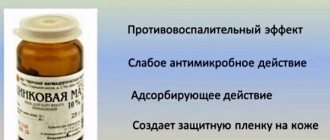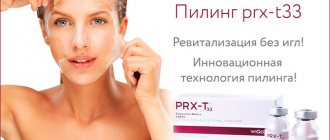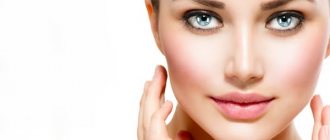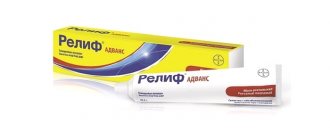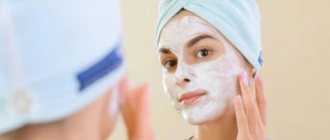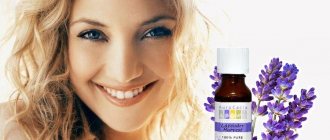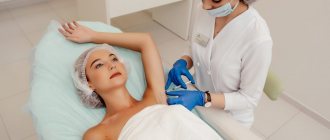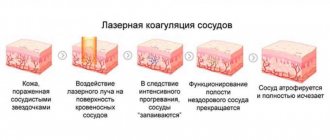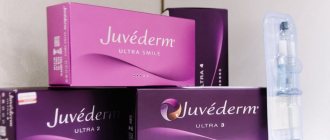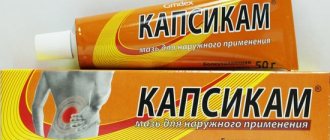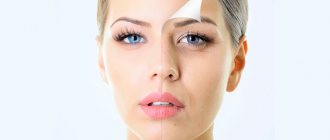Heparin ointment in cosmetology is used both independently and in combination with other care products for the face and around the eyes.
The effectiveness of the drug is due to its composition. The active component penetrates deeply into the dermal layers, narrows pores, and restores blood flow in the area of the defect.
Rules for use, effectiveness of use for various cosmetic imperfections of the face and reviews of cosmetologists about heparin ointment for wrinkles in cosmetology are described in this article.
Heparin ointment in cosmetology (benefits)
Heparin ointment is a direct anticoagulant of the group of medium molecular heparins for external use. The drug has a local anticoagulant, anti-inflammatory and anti-exudative effect, preventing the formation of blood clots.
The composition of liniment includes:
- Heparin. Improves blood flow through blood vessels and reduces the risk of blood clots due to its anticoagulant effect.
- Benzocaine. Has a local anesthetic effect.
- Benzyl nicotinate. The component dilates blood vessels, improves the tone of vascular walls, increases their elasticity and permeability.
The combined effect, based on the pharmacological action of three components, copes with swelling, relieves redness, smoothes the skin, and increases its turgor.
Heparin reduces inflammation, restores blood microcirculation, so after using the ointment, swelling goes away, bruises and hematomas quickly resolve.
Dermatologist Azadeh Shirazi
Application in cosmetology is due to the following properties:
- relief of edema by improving blood circulation and lymph flow;
- activation of regenerative processes at the cellular level;
- ensuring access of oxygen to cells;
- blood thinning and blood clot prevention;
- dilation of blood vessels, improvement of blood flow (this action has a therapeutic effect for rosacea);
- detoxification due to anti-exudative action.
With proper use of heparin ointment in facial cosmetology, good aesthetic and therapeutic results can be achieved.
After a week of regular use, liniment significantly reduces the depth of wrinkles, slows down the aging process, and accelerates the resorption of hematomas and bruises.
Compound
This is a medicine that is used to treat varicose veins and other related conditions. It is white in color with a slight yellowish tint and is used externally. It has local anti-inflammatory and analgesic properties, prevents the formation of blood clots, and promotes the rapid resorption of existing ones. It can be used on abrasions, bruises and contusions.
The main active ingredients are benzocaine 40 mg and sodium heparin 100 mg per 1 gram of the drug. Excipients in the ointment may vary slightly from manufacturer to manufacturer. Typically, these are: soft white paraffin, glycerin, vegetable oil (sunflower, corn, peach...), benzyl nicotinate, emulsifier, methyl parahydroxybenzoate and water. In some cases, it is possible to use additional or replacement substances.
Usually sold in 25 g tubes, stored at room temperature. It is not recommended to apply to the skin together with medications that contain tetracycline, salicylic acid, hydrocortisone, and anticoagulants.
Anti-wrinkle remedy
Heparin anti-wrinkle ointment is really effective for the face, thanks to the main component heparin.
The therapeutic complex penetrates deeply into the subcutaneous structures, increasing tone due to the synthesis of elastin and the formation of collagen fibers.
Thus, the skin texture is smoothed, and minor or early age-related changes completely disappear.
Heparin facial ointment for wrinkles in cosmetology can be used instead of the usual day cream or spot-on, for example, in the area of spider veins and wrinkles, post-acne marks.
How to use heparin ointment for wrinkles? Applying the cream requires following a certain algorithm:
| Stage | Photo |
| Pre-washing, cleansing or removing makeup using special products. | |
| Apply the cream with soft massage movements with your fingers or a clean sponge. | |
| Excess is removed with a napkin. |
The method of using heparin ointment in cosmetology for the face against wrinkles is simple, does not take much time, and can become part of a course therapy.
When treating facial skin, it is important to avoid getting the ointment on the mucous membranes of the mouth and eyes.
Dermatologist Michael Greenberg
After application, wash your hands with soap and moisturize with cream. Reviews from women about heparin ointment for facial wrinkles in cosmetology are positive, only in the case of unexpressed age-related changes.
Deep creases, facial wrinkles and extensive age-related changes require radical intervention.
For wrinkles around the eyes
Reviews on the use of heparin ointment for the face and eyes in cosmetology prove its effectiveness against “crow’s feet” on the outer corners of the eyes, against increased swelling and bags.
Almost immediately after application, heparin penetrates deeply into the dermal layers, enhances and restores blood flow, improves metabolic processes, which activates the production of elastin and collagen.
After just a few days, wrinkles around the eyes are smoothed out, the skin becomes smooth and rested.
To preserve beauty and youth, it is recommended to apply the drug in a thin layer with your fingertips. According to reviews, the price of heparin ointment for wrinkles under the eyes varies between 150 rubles.
Reviews of heparin ointment for wrinkles under the eyes of women of different ages differ. Some talk about the ineffectiveness of the drug, others are shocked by the positive results.
Real reviews from cosmetologists about heparin ointment for wrinkles indicate that it is important to take into account many criteria, ranging from age to the client’s clinical history.
To improve the appearance and treat fine wrinkles around the eyes, apply the product morning and evening.
Heparin ointment with vitamins A, C, E will help improve aesthetic results.
Dermatologist Azadeh Shirazi
Contraindications and side effects
Since heparin ointment is a medicine, it has a certain list of contraindications and side effects. The product cannot be used if:
- Individual intolerance to components has been reported;
- a person suffers from ulcerative-necrotic processes, i.e. there are ulcerations on the mucous membranes or death of living tissues;
- there are open infected wounds;
- for hemophilia
- and poor blood clotting;
- the human body is prone to bleeding;
- history of deep vein thrombosis;
pregnancy and lactation period.
- Manufacturers note that it is almost impossible to overdose on heparin, since the drug has a low absorption rate. However, it is possible to identify side effects that occur in case of non-compliance or an allergic reaction:
- redness of the skin, the appearance of rashes and irritations;
- local swelling and even small blisters;
Acne ointment
Before applying heparin ointment for acne to facial skin affected by acne or pimples, it is recommended to do a mandatory test for allergic reactions.
This is important to eliminate negative consequences in the form of irritation, increased rashes, suppuration of existing acne, itching and burning. Application is possible only in the absence of a positive response to the allergy test.
How to apply heparin ointment for acne on the face? It is recommended to apply the ointment locally. First, the skin is cleansed of dirt and makeup, then treated with an antiseptic. Only then apply to the affected areas.
The course of treatment is 5-7 days 3-4 times a day. Local treatment can be continued until the defect is completely healed. According to reviews, heparin ointment for acne can be used both on the face and body: forearms, neck, shoulders, back. Treatment is not carried out in several cases.
INDICATIONS
- allergies and individual intolerances;
- mature acne, suppuration of acne;
- generalized acne, pimples;
- purulent-inflammatory rashes on the face (boils, carbuncles);
- neoplasms, large moles.
Positive reviews of heparin ointment for acne on the face are due to minor damage to the epidermis.
Reviews on forums about heparin ointment for acne on the face show that the drug is effective only at the initial stage of pimple formation: redness, slight inflammation, subcutaneous tension, and also after healing.
When applied to purulent acne, the risk of developing negative reactions increases. It is better to apply antibacterial and anti-inflammatory drugs such as Levomekol.
During the entire treatment period, you should not use decorative cosmetics or apply too oily care products to prevent the appearance of new pimples and comedones.
Effect on the condition and restoration functions of the skin
The positive cosmetological effect of the drug on the skin is reflected in:
- nutrition of the surface layers of the skin;
- eliminating edema;
- fight inflammation;
- increased metabolism;
- giving a beautiful tone to the skin of the face;
- removal of rosacea.
Similar characteristics of the product are relevant for both tired, dull skin and problematic skin with acne.
The justification for using the product to combat wrinkles lies in enhancing the restoration functions, namely: improving microcirculation, cell renewal and their saturation with useful substances, as well as comprehensive tissue nutrition. At the same time, there is a positive effect on shallow wrinkles that appear as a result of age-related changes and facial contractions of the facial muscles.
However, for more effective use of the anti-wrinkle drug, it is worth adding it to comprehensive skin care.
An exceptionally comprehensive approach with a multi-level skin care system will help in the fight against age-related changes, including the appearance of the first wrinkles.
Post-acne treatment
Heparin ointment is used for acne and post-acne. Traces of post-acne can significantly complicate the quality of life, lead to complexities, and psycho-emotional disorders.
Scarring of the skin leaves whitish marks that do not tan in the sun, are noticeable to others, and therefore require correction. Heparin ointment can smooth out shallow scars.
After application, there is an improvement in turgor, leveling of the relief, and a decrease in the visibility of the scar defect.
The application scheme is simple. First, the face is cleansed of cosmetics and impurities, treated with a scrub and antiseptic, and then heparin liniment is applied. The course of treatment is 10-14 days, 2 times a day. Afterwards they take a break of 10 days and continue treatment if necessary.
To treat traces of post-acne with heparin ointment for acne, you can use the following product with heparin: the drug is combined with ascorutin liniment (in a 1:1 ratio), a powdered tablet of ascorbic acid. The composition is applied 2 times a day to the area of vascular changes.
Experts' point of view
Doctors still have not come to a consensus. Some are firmly convinced that any drug should not be used for its intended purpose. Others, on the contrary, emphasize that heparin ointment really helps smooth out wrinkles. But only if the latter arose due to problems with metabolism and blood circulation.
Cosmetologists note that it is wrong to make a panacea for wrinkles out of heparin. They justify their point of view by the fact that this drug is not so powerful as to replace a whole range of professional cosmetic products.
Experts give advice: the use of heparin ointment will be most effective if combined with other anti-aging procedures and means.
Heparin against dryness and irritation
Heparin has a beneficial effect on dry and irritated skin. The scheme is the same.
You should first do an allergy test. Thanks to deep penetration into the thickness of the subcutaneous structures, heparin activates metabolic processes, intracellular metabolism, helps retain moisture and prevent peeling.
Deep hydration is due to the composition of the drug:
- Heparin improves blood circulation, saturates cells with nutrients and oxygen, and has a powerful detoxifying effect on intercellular structures.
- Benzyl nicotinate also moisturizes, prevents drying, and improves the permeability of heparin molecules through the vascular walls.
A popular mask for intensive hydration of dry and flaking skin is a combination of vitamin A, heparin, peach oil (5 drops), glycerin (5 drops). All ingredients are thoroughly mixed, applied in the evening to previously cleansed skin, left for 30 minutes, then wiped with a dry paper towel. Do not wash off!
Afterwards, irrigate your face with micellar water and blot with a paper towel. This completes the care procedure. Reviews claim amazing results: the skin is evened out, becomes fresh, elastic, moisturized and looks healthy.
Heparin ointment for bags under the eyes
Reviews of heparin ointment in cosmetology for bags under the eyes are positive if the condition is not caused by organ failure or severe diseases of internal organs and systems.
The skin area around the eyes is highly sensitive to external factors. The skin under the eyes has virtually no subcutaneous fat and is prone to drying out and the appearance of early wrinkles.
The appearance of bags under the eyes with a bluish tint is caused by the accumulation of fluid, is a consequence of physiological characteristics or pathologies such as:
- renal failure;
- diabetes;
- severe heart and vascular diseases;
- arterial hypertension;
- somatic pathologies.
Physiological causes include simple fatigue, lack of sleep, drinking too much before bed, eating aggressive food and alcohol.
Bruises can also occur as a result of a violation of the outflow of blood and lymph in the area around the eyes.
Dermatologist Michael Greenberg
In cosmetology, heparin ointment for bags under the eyes is applied in a thin layer to the skin in the eye area in the morning after waking up and before going to bed. For better distribution, it is recommended to apply the skin with your fingertips.
You can make a mask from the following components: heparin liniment is mixed with glycerin (3 drops), rose, peach and sea buckthorn oils (2 drops each).
The composition is thoroughly mixed, applied to the area under the eyes and covered with cling film, previously cut into patches. The mask is kept for about 15-20 minutes, then removed with milk or lotion.
Possible side effects
Heparin ointment can cause a number of side effects:
- when distributing heparin ointment on the face, there is a possibility of acne, which is explained by blockage of pores and the inability to remove subcutaneous fat;
- too frequent use of eye product leads to weakening of the walls of blood vessels, they will become more fragile and brittle;
- when using heparin ointment in hot or cold weather, subcutaneous hemorrhage is likely;
- the likelihood of dry skin and flaking.
In addition, a woman may experience complications in the form of the following symptoms and diseases:
- bleeding caused by excessive application of the drug;
- dermatitis, urticaria, Quincke's edema.
Contraindications (7 prohibitions)
Despite its over-the-counter release from pharmacies and external use, the drug has a number of contraindications for application to the face and body.
CONTRAINDICATIONS
- various blood pathologies (coagulation disorders, hemophilia);
- open bleeding wounds on the face and body;
- tissue necrosis in the area where the cream is applied;
- cirrhotic liver damage;
- neoplasms, pigment spots and large moles in the affected area;
- menstruation;
- children under 18 years of age.
A topical anticoagulant is not recommended for use during pregnancy. Usually the drug is well tolerated and does not cause side effects. The development of allergic reactions requires discontinuation of use.
Expert opinion
- Cosmetologist
- Surgeon
Anna Avaliani
practicing cosmetologist
Heparin ointment is a medical product. Indeed, with its help you can improve the condition of the skin, but the drug is not able to remove deep creases. Be careful when experimenting with home methods.
Sheila Nazaryan
plastic surgeon
This drug is designed to thin the blood.
But over time, they began to use it to combat cosmetic problems. Many women praise the product. This is a local anticoagulant that dilates blood vessels and improves blood circulation. It perfectly fights swelling and inflammation. Reviews of heparin ointment in facial cosmetology are in most cases positive. But many women still say that the drug can only help with minor cosmetic defects. Major deficiencies can only be eliminated using hardware or injection techniques.
If you are concerned about inflammation and acne
Statement: Alcohol tincture of calendula is an effective solution that has a drying effect on ulcers and inflammations and promotes their healing.
This is a myth:
Calendula itself and its decoctions have excellent natural properties to relieve inflammation, soothe and tone. It is prescribed in the complex treatment of sore throats for gargling, because it reliably and quickly soothes sore tonsils and restores health. But, an alcohol solution of calendula, as well as alcohols in general, are harmful to the skin and can cause the opposite result. Firstly, they will increase the production of sebum, and secondly, it is easy to get a burn and any other unpredictable reaction to such manipulations.
Claim: Levomekol ointment is inexpensive, promotes the healing of wounds and burns, and can cure acne and make it less noticeable.
This is partly true:
The active component of levomekol is chloramphenicol, an antibiotic that has a direct antibacterial purpose. Acne and inflammation are also sometimes caused by bacteria and are of a hygienic nature. A short course or as an additional “lotion” this thing will help. However, there are special cosmetic preparations that are created to treat acne and blackheads while minimizing damage. The nature of acne is not always hygienic. These may be physiological or hormonal processes, malfunctions in the body. In these cases, levomekol is powerless.
Claim: Zinc ointment, due to its drying properties, can also effectively fight acne and inflammation.
This is partly true:
Preparations with zinc are used in dermatology to treat diseases such as eczema, trophic ulcers, dermatitis accompanied by weeping, diaper rash, herpes, and diathesis. Yes, zinc ointment can stop the inflammatory process and, when applied to a spot on an abscess, can suppress the growth of bacteria that provoke inflammation. But it is not suitable as a full-fledged treatment for pimples and acne for several reasons: zinc has the ability to whiten the area of application due to the zinc contained in it, it is very dense in composition and can clog pores, thereby aggravating the problems. It is very poorly absorbed.
